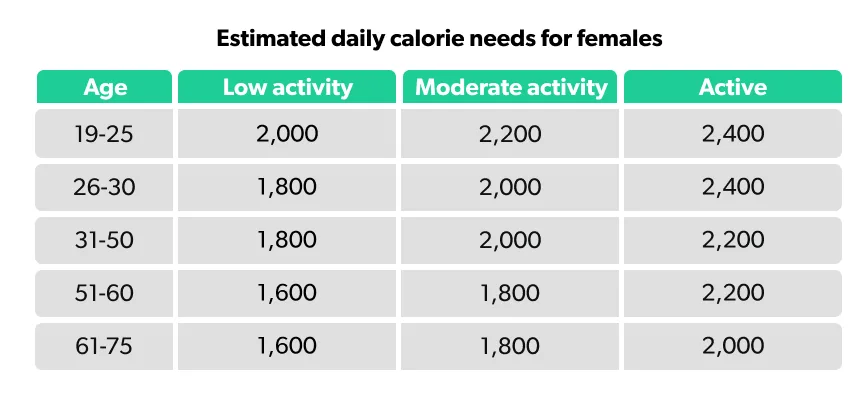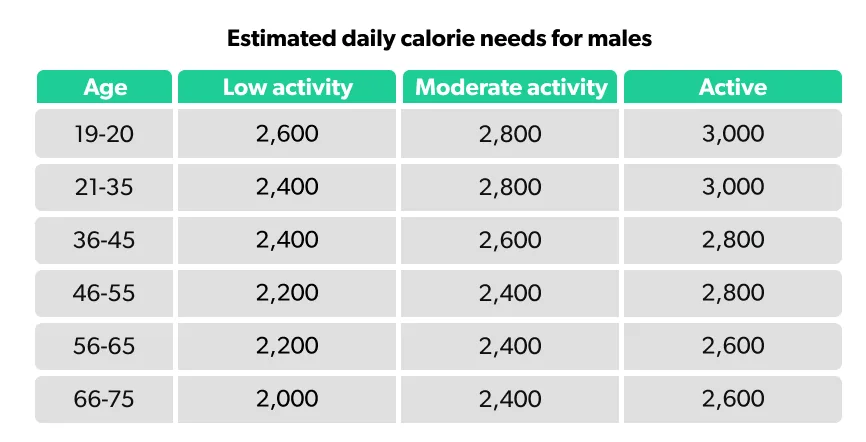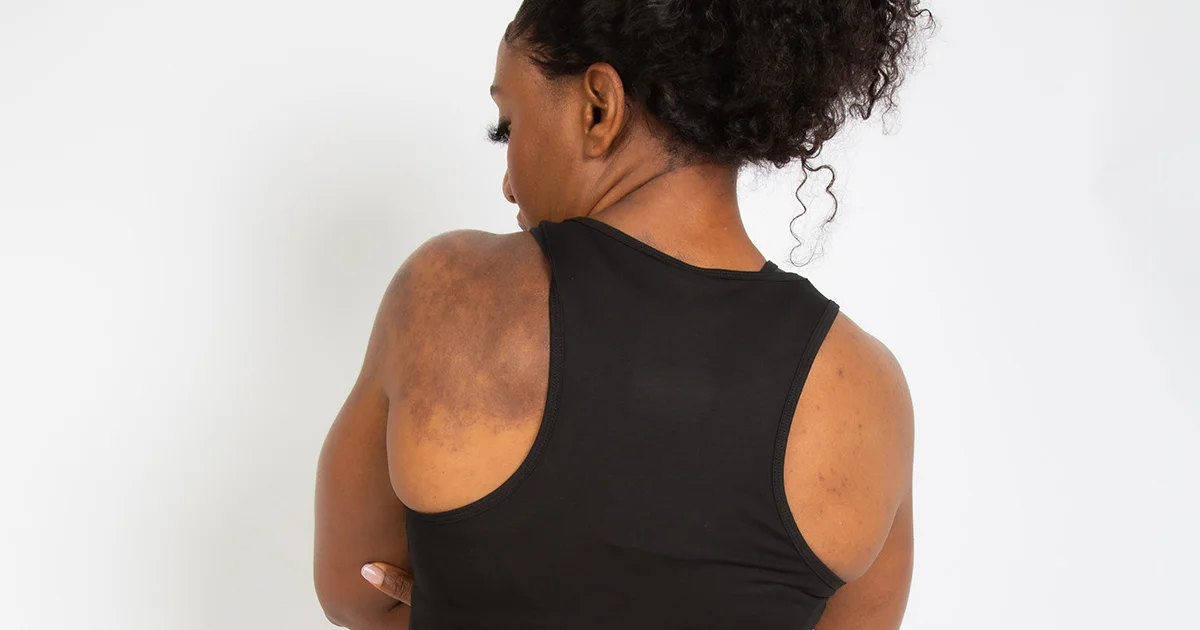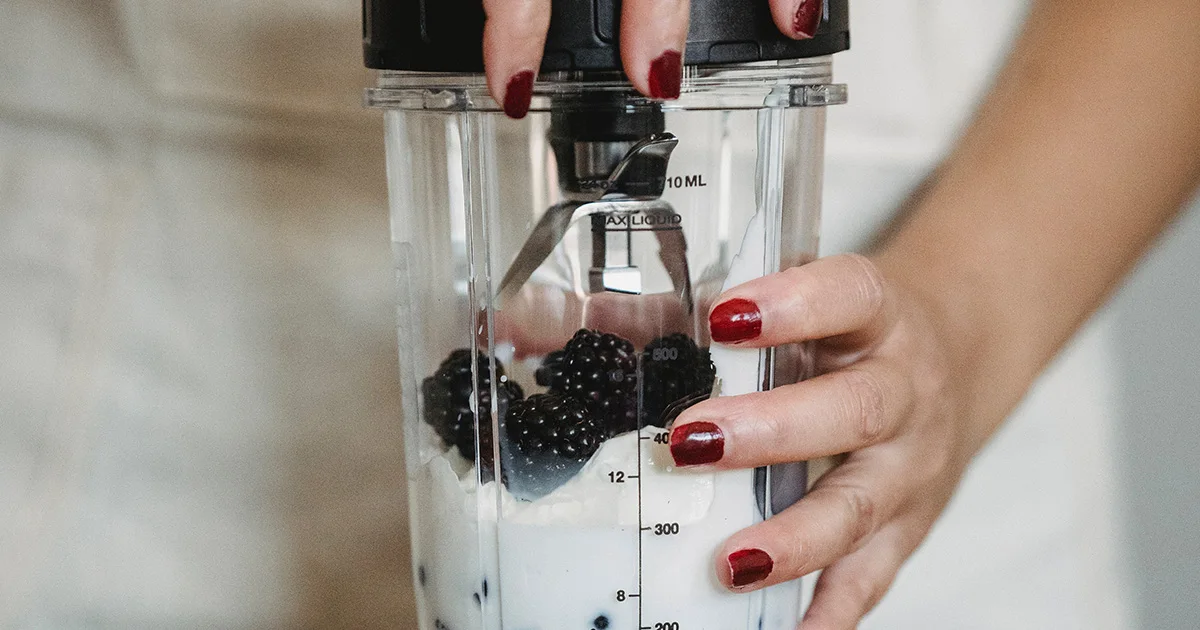Here's what we'll cover
Here's what we'll cover
In the most simple terms, maintaining your weight is a balancing act between how many calories you take in from food and the amount you burn—or expend—daily. The number that balances the equation for one person may be too much or too little for you. So, the answer to the question, “how many calories do you need to maintain weight?” will be different for each person.
Here, we’ll dive into exactly what influences your body’s energy (or calorie) expenditure and offer guidance on calculating your daily calorie needs as an estimate for how many calories you should be eating to maintain your current weight.
What influences daily calorie intake needs?
Calories are a unit of measurement for energy. The words are often used interchangeably, as calories from food provide your body with energy to fuel everything from keeping your heart pumping to running a marathon. The amount of calories you burn per day is called your energy expenditure (Popson, 2021).
You can’t calculate how many calories you need to maintain weight without first knowing your daily energy expenditure. A variety of factors influence how much energy you burn, but the three main categories are:
Basal metabolic rate
Thermic effect of food
Physical activity
Basal metabolic rate (BMR)
BMR refers to how much energy the body burns each day to maintain vital body functions at rest (Sabounchi, 2013). Even when you’re sitting on the couch watching Netflix, your body uses energy to keep your blood circulating and your organs (like the heart, kidneys, and brain) functioning.
Body composition (i.e., how much fat mass vs. lean muscle mass you have) also impacts your BMR. Lean muscle mass burns more calories at rest than fat mass—everything else remaining equal. This means a leaner person will burn more calories at rest than a person of the same weight.
BMR is the largest contributor to your daily energy expenditure—accounting for around 60% of total energy (Popson, 2021).
Thermic effect of food (TEF)
The TEF refers to how much energy is needed to digest the food you consume, absorb nutrients from it, and convert some of those nutrients to energy while storing others. About 10% of your total daily energy expenditure goes toward these processes (Howell, 2017). So yes, you even burn calories while eating!
TEF may be influenced by meal composition (protein tends to take more energy to digest than other nutrients) and the size of the meal, in addition to a person’s age and level of physical activity (Calcagno, 2019).
Physical activity
The amount of physical activity a person gets is the most variable contributor to energy expenditure. For someone who is not very active, physical activity may only contribute 15% of daily energy expenditure, whereas it may contribute up to 50% for very active people. So, being more active requires more calories.
Other contributors
Age and sex also play a role in daily energy expenditure. Males tend to have higher energy needs, on average, than women, largely due to body size and having more lean muscle mass. BMR declines with age for both sexes (Bredella, 2017; Moe, 2007).
How many calories do I need to maintain my weight?
As you can probably imagine, with so many factors affecting your daily calorie needs, this isn’t such a simple question to answer. But we can give you some guidelines.
To maintain your weight, you’ll need to figure out (roughly) how many calories you expend in a day, then aim to take in the same amount of calories on average—eating more could lead to weight gain, and eating less could lead to weight loss.
The 2020 Dietary Guidelines for Americans provide target daily calorie intake ranges to promote a healthy weight, accounting for the factors described above as well as age and sex (USDA, 2020). Remember, these are averages, so try not to get too hung up on these numbers.
Daily calorie intake for women
Most adult women need between 1,800 to 2,400 calories per day. That range drops slightly after the age of 31 to 1,800 to 2,220 calories daily, and then to 1,600 to 2,000 for those 61 and older (USDA, 2020).

Daily calorie intake for men
Men’s daily calorie needs are slightly higher than women's. This is due to generally higher body mass, and even at the same body weight, men (on average) carry more lean body mass than women. Most adult men 65 years of age and under need around 2,200 to 3,000 calories per day (USDA, 2020).

Looking for a more specific number? Try this calculation
The ranges listed above are generalizations for the average population. They don’t account for your specific height or weight. To figure out your specific calorie needs, you’ll need to first calculate your BMR. To get started, you’ll first need to know your weight in kilograms (kg) and height in centimeters (cm).
2.2 lbs = 1 kg
1 inch = 2.34 cm
Then, plug those numbers into one of these equations.
BMR for males = (9.99 x weight in kg) + (6.25 x height in cm) – (4.92 x age) + 5
BMR for females = (9.99 x weight in kg) + (6.25 x height cm) – (4.92 x age) – 161
If your only activity is light day-to-day movement, then your total from that calculation is your BMR. Otherwise, multiply the total by one of the numbers below depending on how active you are (Dwyer, 2015).

Now, that’s your BMR and an estimate of how many calories you need to maintain your current weight.
What about calories for weight loss?
Weight loss, on the other hand, requires you to eat fewer calories than you expend. So calories out need to exceed the calories you take in (Howell, 2017). If weight loss is an appropriate goal for you, consult with a registered dietitian or healthcare professional to determine a healthy and sustainable caloric deficit.
Find out your daily calorie needs
Quickly calculate your total daily energy expenditure to optimize your diet, fitness, and weight goals.
Maintain your current weight
----
CAL DAILY
Lose one pound per week
----
CAL DAILY
This TDEE calculator gives a general estimate and isn't medical advice. Everyone's body is different. For guidance that’s tailored to your health and goals, it’s always best to speak with a healthcare provider.
Other factors that affect weight maintenance
Even careful and precise calorie calculations may not be completely accurate. How your body burns calories also depends on hormonal fluctuations, gut health, and even the type of food you eat.
Hormones: Hormones impact mood, appetite, sleep, and stress levels—which all influence weight (Parmar, 2021). Changes, fluctuations, and disturbances in hormone levels can either help or hinder weight regulation.
The gut microbiome: This refers to the trillions of microorganisms in the large intestine, which may also impact weight. Studies suggest that people with obesity tend to have higher quantities of a specific class of bacteria than people without obesity. The gut microbiome impacts energy and nutrient absorption from the intestines, so one thought is that having more bad bacteria in your gut can encourage weight gain (Aoun, 2020; Parmar, 2021).
Type of food: It turns out that not all calories are created equal. Emerging research indicates that eating highly processed foods may lead to people eating more calories compared to eating unprocessed foods, even when the same amount of calories were available to be consumed at a meal (Hall, 2019).
5 tips for maintaining a healthy weight
Successful weight maintenance depends on more than just counting calories. Healthy lifestyle changes can help you stay at your goal weight.
Get enough sleep: Poor quality sleep and not sleeping enough negatively impact hormones that regulate satiety and metabolism. So proper sleep is important for energy balance (Ding, 2018).
Manage stress levels: Prolonged stress can lead to a rise in the hormone cortisol, which has been linked to weight gain and a preference for high-calorie foods (Parmar, 2021). Practicing stress management techniques like meditation may help lower cortisol levels (Koncz, 2021).
Eat enough lean protein: Eating at least 25–30 g of protein per meal may help with body weight management, appetite regulation, and satiety (Leidy, 2015).
Hydrate: Drinking water, especially in place of beverages like soda or sweetened coffees, can help decrease extra calorie intake that may contribute to weight gain (Thornton, 2016).
Adopt healthy eating patterns: Focus on consuming whole, unprocessed, nutrient-dense foods like whole grains, legumes, fruits, vegetables, nuts, and seeds, while limiting overly processed foods.
Exercise regularly: Regular exercise is a powerful ally in weight maintenance, especially in preventing weight regain after initial loss (Swift, 2014).
Keep this in mind about calories and weight maintenance
How many calories you need to maintain your weight depends on your daily energy expenditure. This number is dependent on your sex, height, weight, level of physical activity, and metabolic health—in other words, it’s complex. Adopting healthy eating habits and incorporating physical activity can support overall health in the long run.
DISCLAIMER
If you have any medical questions or concerns, please talk to your healthcare provider. The articles on Health Guide are underpinned by peer-reviewed research and information drawn from medical societies and governmental agencies. However, they are not a substitute for professional medical advice, diagnosis, or treatment.
Aoun, A., Darwish, F., & Hamod, N. (2020). The influence of the gut microbiome on obesity in adults and the role of probiotics, prebiotics, and synbiotics for weight loss. Preventive Nutrition and Food Science , 25 (2), 113–123. doi:10.3746/pnf.2020.25.2.113. Retrieved from https://www.ncbi.nlm.nih.gov/pmc/articles/PMC7333005/
Bredella, M. A. (2017). Sex differences in body composition. Advances in Experimental Medicine and Biology , 1043 , 9–27. doi:10.1007/978-3-319-70178-3_2. Retrieved from https://pubmed.ncbi.nlm.nih.gov/29224088/
Calcagno, M., Kahleova, H., Alwarith, J., et al. (2019). The thermic effect of food: A review. Journal of the American College of Nutrition , 38 (6), 547–551. doi:10.1080/07315724.2018.1552544. Retrieved from https://pubmed.ncbi.nlm.nih.gov/31021710/
Ding, C., Lim, L. L., Xu, L., & Kong, A. (2018). Sleep and obesity. Journal of Obesity & Metabolic Syndrome , 27 (1), 4–24. doi:10.7570/jomes.2018.27.1.4. Retrieved from https://www.ncbi.nlm.nih.gov/pmc/articles/PMC6489488/
Dwyer, J. T., Melanson, K. J., Sriprachy-anunt, U., et al. (2015). Dietary treatment of obesity. Table 12, [Estimating Resting Metabolic Rate]. In: Endotext [Internet]. Retrieved on Mar. 28, 2022 from https://www.ncbi.nlm.nih.gov/books/NBK278991/table/diet-treatment-obes.table12est/
Frankenfield, D. C. (2013). Bias and accuracy of resting metabolic rate equations in non-obese and obese adults. Clinical Nutrition (Edinburgh, Scotland) , 32 (6), 976–982. doi:10.1016/j.clnu.2013.03.022. Retrieved from https://pubmed.ncbi.nlm.nih.gov/23631843/
Hall, K. D., Ayuketah, A., Brychta, R., et al. (2019). Ultra-processed diets cause excess calorie intake and weight gain: an inpatient randomized controlled trial of ad libitum food intake. Cell Metabolism , 30 (1), 67–77.e3. doi:10.1016/j.cmet.2019.05.008. Retrieved from https://www.ncbi.nlm.nih.gov/pmc/articles/PMC7946062/
Howell, S. & Kones, R. (2017). “Calories in, calories out” and macronutrient intake: The hope, hype, and Science of Calories. American Journal of Physiology-Endocrinology and Metabolism , 313 (5). doi:10.1152/ajpendo.00156.2017. Retrieved from https://pubmed.ncbi.nlm.nih.gov/28765272/
Leidy, H. J., Clifton, P. M., Astrup, A., et al. (2015). The role of protein in weight loss and maintenance. The American Journal of Clinical Nutrition , 101 (6), 1320S–1329S. doi:10.3945/ajcn.114.084038. Retrieved from https://pubmed.ncbi.nlm.nih.gov/25926512/
Koncz, A., Demetrovics, Z., & Takacs, Z. K. (2021). Meditation interventions efficiently reduce cortisol levels of at-risk samples: a meta-analysis. Health Psychology Review , 15 (1), 56–84. doi:10.1080/17437199.2020.1760727. Retrieved from https://pubmed.ncbi.nlm.nih.gov/32635830/
Moe, B., Angelier, F., Bech, C., & Chastel, O. (2007). Is basal metabolic rate influenced by age in a long-lived seabird, the snow petrel?. The Journal of Experimental Biology , 210 (Pt 19), 3407–3414. doi:10.1242/jeb.005090. Retrieved from https://pubmed.ncbi.nlm.nih.gov/17872994/
Parmar, R. M. & Can, A. S. (2021). Physiology, appetite and weight regulation. StatPearls . Retrieved on Feb. 27, 2022 from https://www.ncbi.nlm.nih.gov/books/NBK574539/
Popson, M. S., Dimri, M., & Borger, J. (2021). Biochemistry, heat and calories. StatPearls . Retrieved on Feb. 27, 2022 from https://www.ncbi.nlm.nih.gov/books/NBK538294/
Ravn, A. M., Gregersen, N. T., Christensen, R., et al. (2013). Thermic effect of a meal and appetite in adults: an individual participant data meta-analysis of meal-test trials. Food & Nutrition Research , 57 . doi:10.3402/fnr.v57i0.19676. https://www.ncbi.nlm.nih.gov/pmc/articles/PMC3873760/
Sabounchi, N. S., Rahmandad, H., & Ammerman, A. (2013). Best-fitting prediction equations for basal metabolic rate: informing obesity interventions in diverse populations. International Journal of Obesity (2005) , 37 (10), 1364–1370. doi:10.1038/ijo.2012.218. Retrieved from https://www.ncbi.nlm.nih.gov/pmc/articles/PMC4278349/
Swift, D. L., Johannsen, N. M., Lavie, C. J., et al. (2014). The role of exercise and physical activity in weight loss and maintenance. doi: 10.1016/j.pcad.2013.09.012. Progress In Cardiovascular Diseases, 56 (4): 441-447. Retrieved from https://www.ncbi.nlm.nih.gov/pmc/articles/PMC3925973/
Thornton, S. N. (2016). Increased hydration can be associated with weight loss. Frontiers in Nutrition , 3 , 18. doi:10.3389/fnut.2016.00018. Retrieved from https://www.ncbi.nlm.nih.gov/pmc/articles/PMC4901052/
U.S. Department of Agriculture and U.S. Department of Health and Human Services (USDA). (2020). Dietary Guidelines for Americans, 2020-2025. 9th Edition. Retrieved from https://www.dietaryguidelines.gov/sites/default/files/2021-03/Dietary_Guidelines_for_Americans-20 2 0-2025.pdf












